Tuesday, November 29--John
Rodsted on "Tom Crean", Luke Saffigna on "Plants of the
Falklands and South Georgia". The
sun came out for part of the morning. Some people supposedly saw whales, but
most of us didn't. I think that really all they saw were the spouts of whales.
We had a mandatory briefing on landing in South Georgia and then cleaned our
parkas, boots, and waterproof p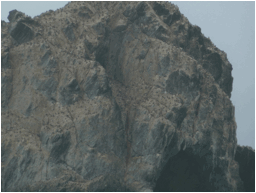
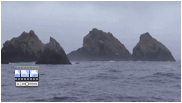
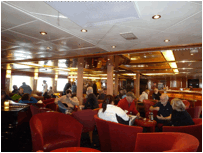
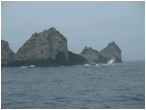 ants for the
landing. It's quite a procedure! The
boots are scrubbed and everything else is vacuumed thoroughly. Right before supper we passed Shag Island,
and I learned that cormorants are called "shags". There were many of
them perched on these rocks--mostly on the lighter colored rock We had a debriefing and the played a quiz
game, in which our team came in tied for last.
ants for the
landing. It's quite a procedure! The
boots are scrubbed and everything else is vacuumed thoroughly. Right before supper we passed Shag Island,
and I learned that cormorants are called "shags". There were many of
them perched on these rocks--mostly on the lighter colored rock We had a debriefing and the played a quiz
game, in which our team came in tied for last.
Wednesday,
November 30-- We reached the bay of Elsehul this morning as scheduled even
though we were several hours late leaving Stanley because of the wind. At about
8:00 the Zodiacs started going out. Our group, Grease, was the first to go out.
The kayakers were also able to go out for the first time. I wore all of my cold weather gear, including
my heaviest underwear, because I 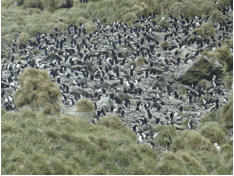
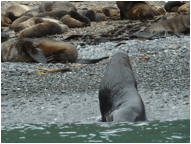
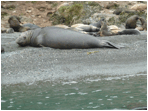
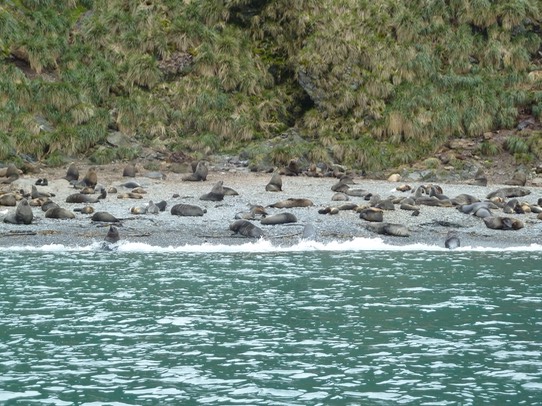
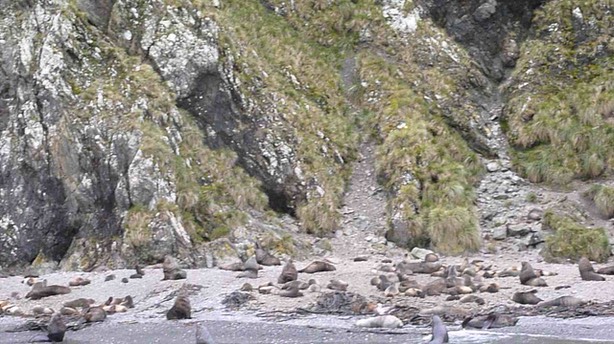
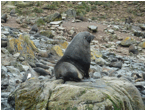
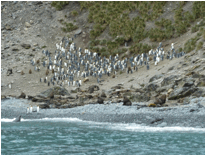
thought riding
in the Zodiac for two hours would be cold--and it was! I was ok. Tom seemed a little cold, but he
didn't wear all the cold weather stuff. I think he was especially sorry he
didn't wear the waterproof gloves. We saw many seals both in the water and on
land, enormous sea lions, many penguins, and other birds. I wasn't able to hear
all that was said and to distinguish each kind of animal, but there were a lot
of them, and they seemed totally unaffected by us. We came back to the ship
after about two hours, rested, and ate lunch while the ship moved to Salisbury
Plain on the southern shore of the Bay of Iles. We visited the second largest
king penguin colony on the island--about 60,000 breeding pairs or about 250,000
individuals. It's amazing to see! Among
the penguins,especially near the shore, were many fur seals and some elephant
seals. As we walked we went around the seals and watched them. We're supposed
to stay at least 15 feet from the wildlife and a little more from the seals.
However, those that seemed even slightly aggressive were discouraged when one
of the expedition team members basically told them to go away or knocked two
rocks together. 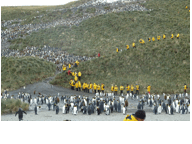
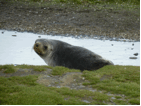
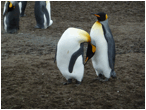
Click on the image above to see the young penguin following a parent.
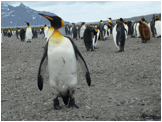

Some of the group climbed the hill on which some of the colony was to look down on it, but we stayed down and just watched the penguins. They would come right up to us and just stand there looking at us. There was a lot of noise from the penguins and from the seals. The smell wasn't bad at all--nothing like what I would have expected that many birds and animals to smell. We were in the first boat to return to the ship. Both Gail and Mollie returned when we did. We had hot drinks after we changed out of our expedition clothes and I later decided that a gin and tonic would make my back feel better--which it did! The staff took time at the beginning and end of the first excursion to show us the procedures for cleaning any equipment we might take out with us, checking out, washing our boots, and on return checking in and cleaning our boots again. They are very careful to try not to introduce any foreign life to the environment.
Thursday, December 1--Hikers walked from Fortunate Bay on the Shackleton Walk. Kayakers disembarked at Leith. We were put off at Stromness, where we walked partway up Shackleton's Walk to see a waterfall. It was much harder than I had expected because I had on too many clothes so was really hot and the ground was either wet and soggy or rocky. There were a few king penguins, some fur seals, and a few elephant seals. We also saw rain deer on the distance. This was a whaling station, but is now derelict. After lunch the ship moved on to Grytviken where we saw Shackleton's grave in the cemetery of around 30 graves. Frank Wilde's ashes had been buried there just a few days ago. They were consecrated (?) by the minister from the church in the Falkland Islands. Frank Wilde was Shackleton's second in command on at least one trip and made many trips to Antarctica. We also visited a nice museum and bought and sent postcards to grandchildren, Josiah, and Lee. We visited the church which was built in 1914, and has been restored. They said it was still used occasionally, but there are only three people on the island. We aren't sure whether they stay through the winter or not. There was snow off and on all day, but the sun came out often. We hadn't moved by the time we went to bed.
Friday, December 2--We
started moving around 5:00 this morning and apparently had only a couple of
hours to go to our next site. We caught a glimpse of another ship, which we
understand is shadowing us--I think in case either of us should have trouble.
Again, there was a little snow, but it's pretty much ignored. Our first stop
was at Ocean Bay. Here we saw the wreck of the Bayard, a whaling ship and a
small steam locomotive that apparently was used in the whaling station. Almost
everything in the whaling station had been moved to Stromness long ago. We saw
more king penguins, some elephant and fur seals, and shags or cormorants on the
Bayard. There were also several herds of rain deer. I had thought that we would
just sit and watch the animals, but Tom decided that he wanted to take the walk
along the ridge. Once again, it was harder than it looked. What we thought was
the only hill, right at the beginning, turned out to be the first of several.
Unfortunately, I really get out of breath on climbs. However, we did make it.
Luke hovered nearby to be sure we weren't in real trouble. The staff on this expedition are really
great. They take care of us even when we
are not quite doing things well and are genuinely kind and encouraging. We reached the top of the ridge and 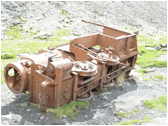
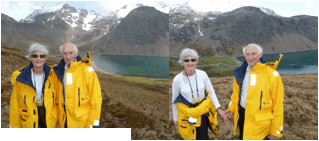
did have an excellent view of the bay.
Luke took pictures of us about halfway up and then at the top. The trip
down was much easier than the trip up!
The kayakers had beautiful still water here. When everyone was loaded, we moved on to St.
Andrews Bay where there was South Georgia's largest king penguin colony. There were hundreds of thousands of king
penguins, but there were also even more of the elephant seals than we've seen
before. One of them particularly was enormous. The wind was terrific here! It would periodically blow small particles of
grit or sleet that were very hard on our faces, and the only recourse was to
turn our backs. We are really well outfitted with our parkas and these great
insulated rubber boots. The ride in on the Zodiacs was a little exciting with
everyone getting sprayed some, but the ride back was even m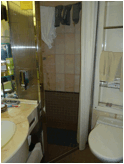
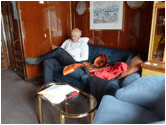
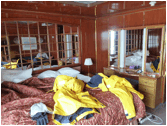 ore so. The wind had come up even more and made
getting into the Zodiacs on shore and then getting off at the ship a real
adventure! Everyone was sprayed this
time. The day's activities were finished
with a recap and briefing. Our cabin is looking and feeling quite lived in.
ore so. The wind had come up even more and made
getting into the Zodiacs on shore and then getting off at the ship a real
adventure! Everyone was sprayed this
time. The day's activities were finished
with a recap and briefing. Our cabin is looking and feeling quite lived in.